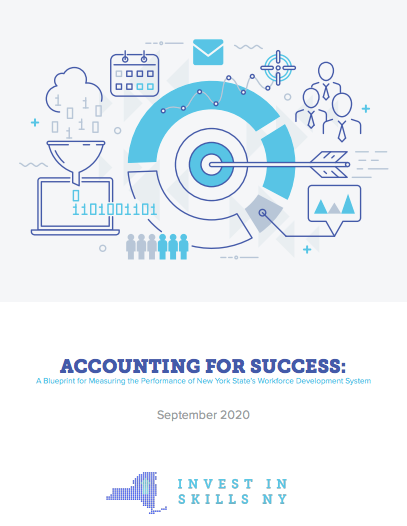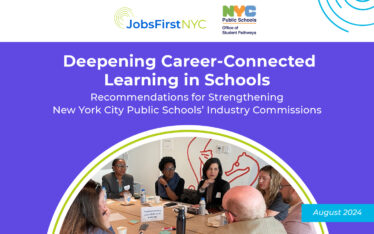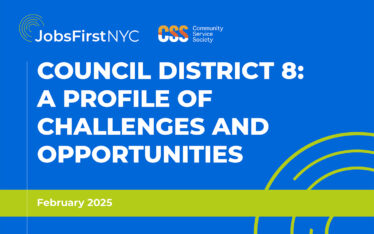This policy brief, Accounting for Success: A Blueprint for Measuring the Performance of New York State’s Workforce Development System, focuses on building a 21st-century data infrastructure for New York State’s workforce development system. A unified postsecondary and workforce data system is indispensable for connecting labor supply with labor demand. This need is even more urgent in light of the unprecedented shift in the labor market due to the global COVID-19 pandemic, which has left many New Yorkers unemployed and in need of reskilling. Unfortunately, because New York’s workforce development system lacks a comprehensive approach to data, the state’s ability to adequately respond to pandemic-induced changes in the labor market is limited.
Ideally, such a data system collects and maintains detailed, high-quality information from a range of stakeholders on education, job training, and employment services; connects performance, programmatic, and participant data across agencies; manages data longitudinally over time; tracks and clearly reports on outcomes; and is user friendly to a variety of stakeholders (including employers, jobseekers, and policymakers) interested in understanding performance and progress in the postsecondary education and workforce development sectors.1 Best practices from other states across the country reveal integrated data systems that help users (including policymakers, workforce training providers, employers, and jobseekers) answer a range of questions related to job training and employment.2 Currently, New York’s workforce development system is unable to answer many such questions, including these four:
- How many state residents are currently participating in an education or job training program?
- How effective are these programs in helping people access employment and better wages immediately and over time?
- What is the wage progression for industry-recognized credentials across the state?
- What employment skills are most important from region to region to help New York overcome the economic fallout resulting from the COVID-19 pandemic?
This brief explores the gaps in New York State’s current e orts to capture performance outcomes and trends in workforce development, showcases the best practices of other states that have successfully built comprehensive workforce and postsecondary data systems, and provides guidance to New York policymakers on how to catch up to other states in developing a data-driven workforce development system that can inform investment and programmatic strategies.
Overview of Recommendations and Next Steps:
Recommendation 1: Commit state resources and direct state agencies, in collaboration with local stakeholders (e.g., employers, workforce training providers, and colleges), to build and sustain a comprehensive data system through a transparent and accountable process.
Next Steps:
✓ Use the Workforce Development Quality Campaign’s roadmap to develop a plan to address each of the system’s main elements: a shared vision; cross-agency governance; data sharing; data analysis; capacity building; and privacy and security.
✓ Establish a leadership infrastructure through a repurposed State Workforce Development Board charged with ensuring collaborative and supportive governance based on a shared vision of success for state agency partners and local workforce training providers.
✓ If needed, adopt new legislation that allocates resources and facilitates data sharing and
aligns technological infrastructure across agencies, and that ensures the system’s accountability to the public.
Recommendation 2: Adopt a set of common performance metrics to be used across workforce development programs and funding streams.
Next Steps:
✓ In conjunction with local stakeholders, decide on a comprehensive set of data points to be included in the statewide data system (see table 3 for specific recommendations) that can help the state set workforce and postsecondary goals and measure its progress against those goals.
✓ Develop a “data dictionary” defining key terms for data collection and measurement that can be used across agencies and programs, such the NYS Department of Labor, Access VR, NYS Education Department, the State and City Universities of New York, and others.
✓ Integrate labor market information into the performance management system to provide a single data source for users.
Recommendation 3: Build and test the technical elements of the data system.
Next Steps:
✓ Execute the steps to building a data system presented in section 3 of this brief, seeking financial resources and technical assistance from the US Department of Labor and other federal sources.
✓ Develop end-user support for agencies and providers to ensure that they are able to fully participate in the data system.
Recommendation 4: Integrate the State University of New York (SUNY) and the City University of New York (CUNY) into the statewide data system to better capture workforce outcomes of the state’s public higher education system.
Next Steps:
✓ Map the existing performance data systems currently used by SUNY and CUNY in order to integrate them into a comprehensive statewide system.
✓ Charge CUNY and SUNY leadership with ensuring uniformity across data on non-degree programs and non-credit instructional activities (NCIA), including inputs (enrollment and registration), outputs (completions), and outcomes (credentials earned, further education pursued, and employment and earnings).
✓ Make data on non-degree programs and NCIA courses available in real time, allowing students to make more informed decisions and employers to have up-to-date information on the local talent pipeline.
Recommendation 5: Make data available and user friendly to state and local government agencies, workforce training providers, legislators, employers, and the general public to ensure that it is used to support strong workforce outcomes.
Next Steps:
✓ Ensure that the statewide data system is an external-facing tool that can be tailored to policymakers, agencies, workforce training providers, jobseekers, employers, and others.
✓ Incorporate data visualization and disaggregation—which make information more understandable and straightforward for users—as key elements of the system.
✓ Ensure that the system’s employer interface includes relevant data on the talent pipeline and allows employers to contribute data on needs and projections.
JobsFirstNYC is a co-chair of the Invest in Skills NY coalition alongside the New York Association of Training and Employment Professionals (NYATEP) working in partnership with more than 300 supporters (including employers, postsecondary institutions, and economic and workforce development leaders) to make a skilled workforce a budget and policy priority.
Read the first blueprint published in December of 2018: Leveraging Opportunity, Meeting Demand: A Blueprint for Building New York State’s Workforce Development System outlining strategies for New York State to build a modern workforce development system.
For more information, visit: https://www.investinskillsny.org/





